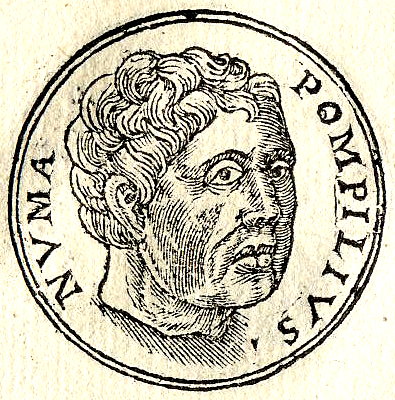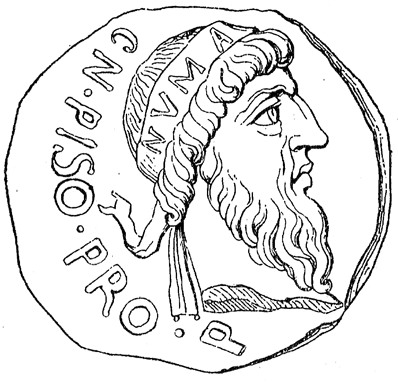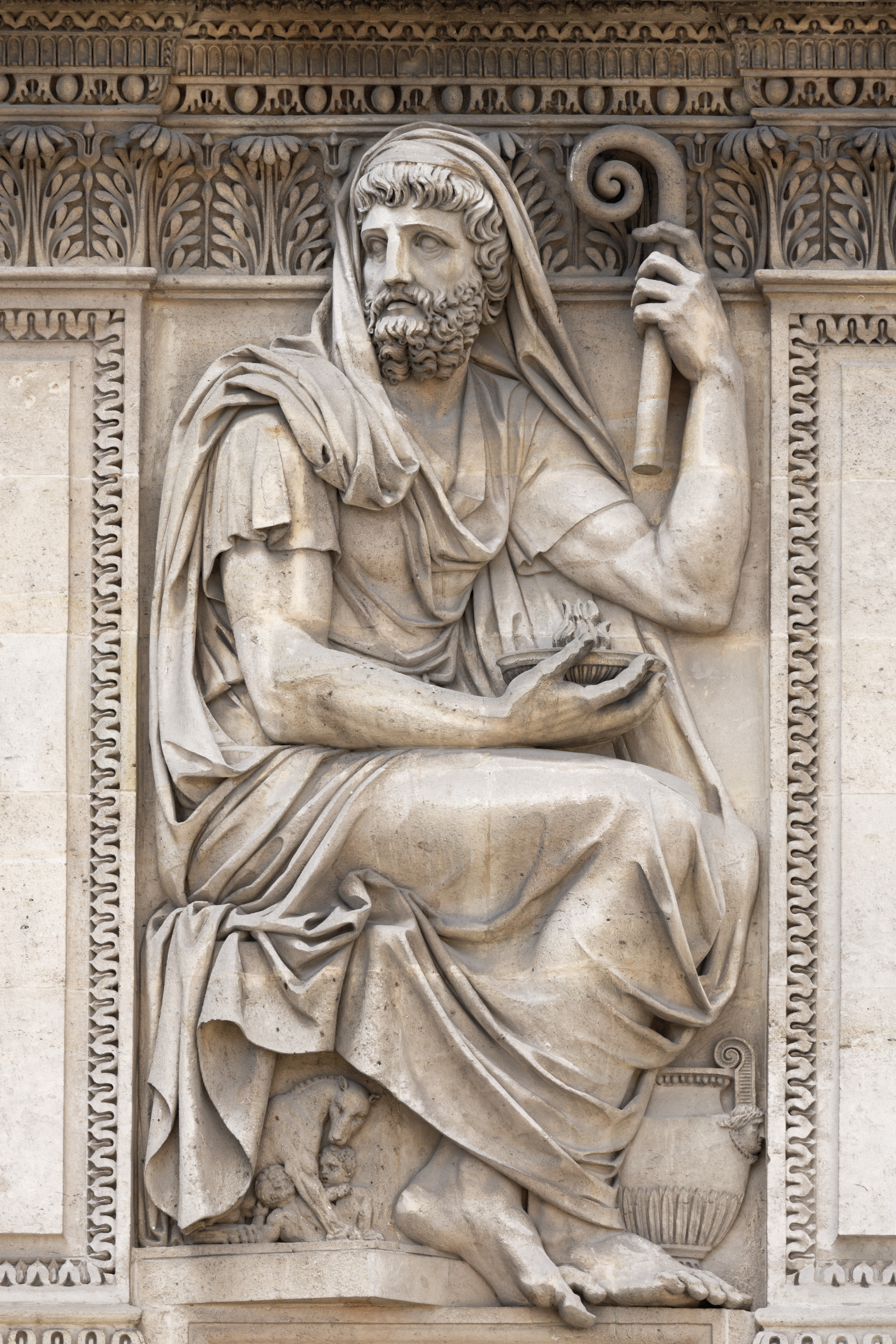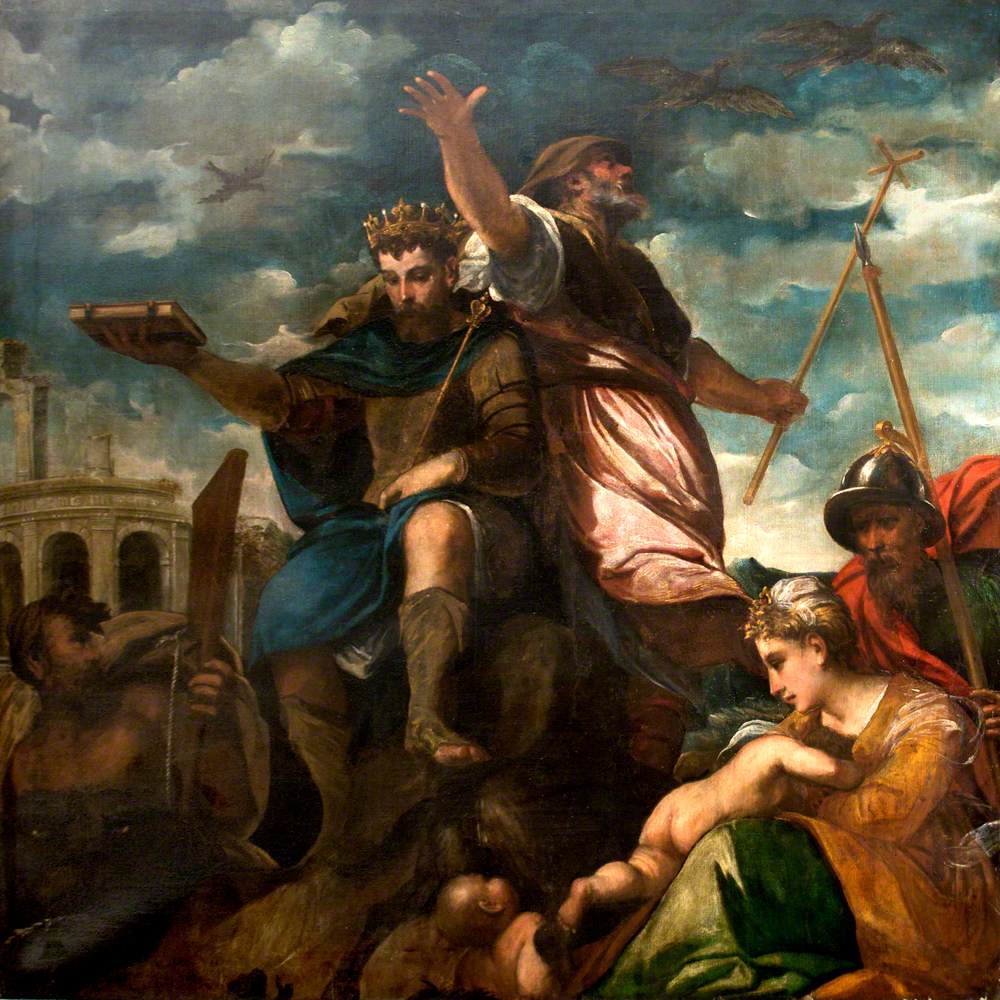1. Overview
Numa Pompilius, a legendary figure, was the second King of Rome, succeeding Romulus after a one-year interregnum. Born on the traditional founding day of Rome (April 21, 753 BC), he was of Sabine origin. Numa's reign, lasting 43 years (715-672 BC), is characterized by peace, piety, and significant internal development, a stark contrast to Romulus's militaristic rule. He is credited with establishing many of Rome's most important religious and political institutions, including the Roman calendar, the Vestal Virgins, the cults of Mars and Jupiter, and the office of Pontifex Maximus. Numa is remembered as a wise lawgiver and a profound peacemaker, transforming Rome from a collection of warlike factions into a structured, law-abiding city.
2. Early Life and Background
Numa Pompilius's early life laid the foundation for his later reign, marked by a disciplined upbringing and a contemplative nature.

2.1. Childhood and Education
Born on April 21, 753 BC, the traditional date of Rome's founding, Numa was the youngest of four sons of Pomponius, a prominent Sabine. He lived a life of severe discipline, banishing all luxury from his home. Numa was known for his love of philosophy and meditation, which some accounts suggest led to his hair turning white at a young age. Ancient historians like Titus Livius (Livy) and Plutarch mention a tradition that Numa was instructed in philosophy by Pythagoras. However, both historians discredit this claim due to chronological and geographical implausibilities, as Pythagoras lived after Numa. Nevertheless, this attribution highlights Numa's reputation for deep wisdom and intellectual pursuits.
2.2. Marriage and Retirement
Numa married Tatia, the only daughter of Titus Tatius, the Sabine king and a colleague of Romulus. Their marriage lasted 13 years, after which Tatia died. This personal loss led Numa to retire from public life, seeking solitude in the countryside. He reportedly did not desire power, preferring a simple and happy life in a small village. According to Livy, Numa resided at Cures immediately before his election as king. Some authors also credit Numa with a daughter, Pompilia, whose mother is identified as either Tatia or a second wife, Lucretia. Pompilia is said to have married Numa Marcius, the son of the first Pontifex Maximus, and their son, Ancus Marcius, later became the fourth King of Rome. Other accounts, though viewed skeptically by some, suggest Numa had five sons-Pompo, Pinus, Calpus, Mamercus, and Numa-from whom noble Roman families like the Pomponii, Pinarii, Calpurnii, Aemilii, and Pompilii claimed descent.
3. Kingship and Succession
The circumstances of Numa's ascension to the Roman throne were unique, marking a transition from a period of conflict to one of peace and internal consolidation.
3.1. Election and Acceptance
Following the death of Romulus, Rome experienced a one-year interregnum during which members of the Roman Senate exercised royal power in rotation, each for five days. In 715 BC, after considerable disagreement between the Roman and Sabine factions, a compromise was reached. The Senate elected the Sabine Numa, who was approximately 40 years old, as the next king. Initially, Numa refused the offer, arguing that Rome, still influenced by Romulus's warlike rule, needed a military leader, not a man of piety and reflection. However, his father, Sabine kinsmen, and an embassy of two senators from Rome persuaded him to accept. According to Plutarch and Livy, Numa, summoned from Cures, was enthusiastically received by the Roman people. Before accepting, he requested an augur to divine the gods' opinion on his kingship. The omens were favorable, and with the approval of both the Roman and Sabine people and the heavens, Numa assumed his position as King of Rome. His first act as king was to disband Romulus's personal guard of 300 celeresSwiftLatin, a gesture interpreted as a sign of humility, a move to ensure his safety from potentially disloyal guards, or an immediate declaration of his peaceful intentions.

3.2. Nature of Reign
Numa's reign, lasting 43 years until his death in 672 BC at the age of 81, was characterized by profound peace and internal development. This period stood in stark contrast to the earlier militaristic era of Romulus. Livy notes that while Romulus was a king of war, Numa was a king of peace, ensuring that Rome became proficient in both the arts of war and peace. Under Numa, Rome experienced a long period without conflict, transforming from a society perceived by its neighbors as a band of brigands into a cultural city founded on law, custom, and sacred rites. Numa's focus was on establishing a stable society, reducing internal conflicts, and fostering a deep respect for the gods and the law. He died of old age and, at his request, was not cremated but buried in a stone coffin on the Janiculum Hill, near the altar of Fons. According to legend, he chose a simple ceremony, not wishing to be buried with wealth or symbols of power. He was succeeded by Tullus Hostilius.
4. Agent of the Gods
Numa Pompilius was widely celebrated by the Romans for his wisdom and deep piety, often depicted as having a direct and personal connection with the divine.

4.1. Divine Inspiration and Egeria's Counsel
Numa's most famous divine connection was with the nymph Egeria. According to legend, Egeria, who some identify with the Greek Muse Calliope, taught Numa to be a wise legislator. Numa was said to have fallen in love with Egeria and met her frequently at Egeria's spring, located south of the Palatine Hill, to receive political advice. Livy recounts that Numa claimed to hold nightly consultations with Egeria on the proper way to institute sacred rites for the city. These divine counsels were believed to be the source of many of Numa's religious and legislative reforms, lending an aura of divine legitimacy to his rule.
4.2. Piety, Superstition, and Aura
Plutarch suggests that Numa strategically used superstition to cultivate an aura of awe and divine allure around himself. This was intended to encourage more gentle behavior among the early, warlike Romans, promoting values such as honoring the gods, abiding by law, behaving humanely towards enemies, and living proper, respectable lives. By associating his reforms with divine will, Numa enhanced his authority and fostered a sense of order and reverence within the nascent Roman society.
4.3. Mythological Encounters and Omens
Numa's legendary interactions with deities extended beyond Egeria. He is reputed to have compelled the minor gods Picus and Faunus to deliver prophecies about future events. Supported and guided by Egeria, Numa reportedly engaged in a battle of wits with Jupiter himself, through an apparition, seeking to obtain a protective ritual against lightning strikes and thunder.
A significant omen occurred during a plague that ravaged Rome. A brass shield, known as the Ancile, miraculously fell from the sky and was brought to Numa. He declared that Egeria had informed him it was a divine gift from Jupiter, meant for Rome's protection. Numa immediately ordered ceremonies to give thanks, and the plague swiftly ended. The Ancile became a sacred relic of the Romans, guarded by the Salii priests. Numa later had eleven identical shields made, so perfect that even he could not distinguish the original from the copies, to ensure the protection of the sacred object.

5. Religious Reforms
Numa Pompilius is widely credited with laying the foundational stones of Roman religious institutions, cults, and sacred rites, transforming the city's spiritual landscape.
5.1. Priesthoods and Offices
Numa established or formalized several key religious roles that became central to Roman religious life:
- Pontifex Maximus: Numa created the office of the Pontifex Maximus, the chief priest responsible for overseeing all religious affairs in Rome. This position became one of the most important institutions in the Roman religious system, with the Pontifex Maximus being entrusted with sacred ceremonies, Numa's religious books, and seals. Livy describes the extensive duties of the pontiffs, including determining hostiaevictimsLatin for sacrifice, sacred days, temples for rites, funding for expenses, and regulating all public and private religious institutions. They also instructed the people on funeral solemnities, appeasing the spirits of the dead, and expiating prodigies sent by lightning or other phenomena.
- Vestal Virgins: Numa brought the Vestal Virgins to Rome from Alba Longa. These priestesses were tasked with guarding the sacred fire of the goddess Vesta, a crucial duty for the continuity of Roman religious life and rituals. Plutarch notes that there were initially two Vestal Virgins, later augmented to four by Servius Tullius, a number that remained constant through the ages.
- Salii: Numa instituted the Salii, priests of Mars Gradivus, who were responsible for guarding the sacred Ancilia (shields) and carrying them in an annual procession.
- Flamines: Numa established the flamines for Quirinus (in honor of Romulus), in addition to the existing flamines for Jupiter and Mars. He created a residentiary flamen to Jupiter, endowed with regal insignia, to carry out the sacred functions of the royal office, especially when the king was engaged in war.
- Fetiales: Numa instituted the Fetiales, a college of priests who acted as intermediaries in declarations of war and peace. This ensured that decisions regarding war were made with moral and religious consideration, promoting a more just approach to conflict.
- Curiones: These priests were in charge of tending the sacrifices of the curiaeassembliesLatin.
- Augurs: Numa formalized the role of augurs, who were responsible for official divination, interpreting the will of the gods through omens.
- Tribuni Celerumtribunes of the swiftLatin: While primarily the king's bodyguard, they also participated in some religious ceremonies.
Numa also dedicated an altar to Jupiter Elicius as the source of religious knowledge and consulted the god through auguries for expiation. He instituted a yearly festival to Fides (Faith), commanding the three major flamines to be carried to her temple in an arched chariot, performing service with their hands wrapped, symbolizing the sanctity of faith. Among other rites, he dedicated places of the Argei. Plutarch also records some of Numa's specific ritual instructions, such as sacrificing an uneven number of victims to heavenly gods and an even number to nether gods; prohibiting libations to gods with wine made from unpruned vines; forbidding sacrifices without flour; and requiring a complete turn on oneself while praying and worshiping the gods.
5.2. Cults and Temples
Numa's religious reforms included the establishment of significant cults and sacred sites:
- Temple of Janus: One of Numa's first acts was the construction of the Temple of Janus, a symbolic indicator of peace and war. Located at the foot of the Argiletum, its doors were closed during times of peace and opened during war. During Numa's entire reign, the temple doors remained shut, a unique instance in Roman history, signifying an unparalleled period of peace. This state of peace was so remarkable that the temple's doors remained closed until the Roman Empire, with the only exception being a six-year period after the Punic Wars.
- Cult of Terminus: Numa established the cult of Terminus, the god of boundaries. This rite involved sacrifices at private properties, boundaries, and landmarks, aiming to instill in Romans respect for lawful property and non-violent relationships with neighbors. Numa preached that the cult of Terminus promoted the absence of violence and murder, with the god serving as a testament to justice and a keeper of peace. He also sought to set the official boundaries of Rome's territory, which Romulus had never done, with the same concern for preserving peace.
- Ancilia: Recognizing the paramount importance of the original sacred shield (Ancile) that fell from the sky, King Numa ordered the creation of eleven identical copies, known as the Ancilia, to protect the original. These sacred shields of Jupiter were carried annually in a procession by the Salii priests.
Numa largely preferred bloodless and inexpensive sacrifices. Plutarch describes the early Roman religion under Numa as imageless and spiritual, forbidding the representation of deity in human or animal form for the first 170 years of Rome's existence. This reflected a belief that it was impious to represent divine beings with perishable forms and that God could only be conceived by understanding. The ritual of the spolia opimarich spoilsLatin and the indigitamentainvocationsLatin (lists of deities invoked for specific purposes) are also attributed to him by ancient sources.
6. Calendar Reform
Numa Pompilius undertook a crucial reform of the Roman calendar, significantly impacting the organization of time and religious observances.
6.1. Restructuring the Roman Calendar
By tradition, Numa promulgated a calendar reform that transformed the existing inaccurate 10-month system into a 12-month one. This new calendar was divided according to the lunar course but was adjusted to align with the solstitial revolution, making it more accurate. During this reform, the months of January and February were introduced. Numa also established a distinction between profane and sacred days within the calendar, influencing daily life and religious practices. Plutarch notes that Numa made January the first month of the year, replacing March, because he wished for civil and political influences to precede martial ones. Janus, the god of beginnings and transitions, was seen as a patron of civil and social order, who had elevated human life from a bestial state. This is why Janus is often depicted with two faces, symbolizing the transition from one state to another.
7. Social and Legal Reforms
Numa's reign was marked by significant initiatives aimed at structuring Roman society, establishing legal principles, and fostering peaceful coexistence and social equity.
7.1. Guilds and Social Organization
To mitigate factionalism and tribal rivalries between the Romans and Sabines, Numa established traditional occupational guilds in Rome. He distinguished the entire populace by their various arts and trades, forming companies of musicians, goldsmiths, carpenters, dyers, shoemakers, skinners, braziers, and potters. All other handicraftsmen were organized into a single company. Each guild was appointed its own courts, councils, and observances, making these communities more important than tribal affiliations and thereby dissolving tribal conflicts. Legal scholar William Blackstone even suggests that Numa could be credited with "originally inventing" corporations, as he subdivided the two rival factions into many smaller ones through these separate societies.
7.2. Land Distribution and Agriculture
Numa was credited with dividing the immediate territory of Rome into pagivillagesLatin. According to Plutarch, he distributed existing land among the indigent people of Rome and encouraged them to engage in agriculture. Numa believed that fostering agricultural work would reduce aggression, eliminate poverty, and consequently decrease crime. He viewed agriculture as an occupation that "fostering character rather than wealth." Plutarch also suggests that Numa's prohibition of making sacrifices without a meal and from unpruned vines was intended to encourage people to work in agriculture, linking religious practice with productive labor.
7.3. Laws on Slavery and Property
Numa introduced specific regulations concerning social order and property rights. He notably forbade fathers from selling their sons into slavery if the son had married according to the father's will, indicating a concern for family structure and individual rights within the Roman household. Additionally, Numa permitted slaves to feast with their masters during the Saturnalia. Plutarch suggests this was a way of "admitting to the enjoyment of the yearly fruits of the earth those who had helped to produce them," possibly in memory of a "Saturnian age" when there was no distinction between slave and master, and all were regarded as kinsmen and equals. Through the cult of Terminus, the god of boundaries, Numa sought to instill respect for lawful property and non-violent relationships among neighbors.
7.4. Peacemaking Initiatives
Plutarch portrays Numa as a powerful peacemaker, with the promotion of peace being one of his primary goals from the very beginning of his kingship. Many of his actions, such as the symbolic closure of the Temple of Janus doors, were directly or indirectly aimed at achieving this objective. His success was so profound that peace extended not only within Rome but throughout Italy. Roads became safe, and feasts and festivals prevailed. Numa's peaceful rule ensured his personal safety; no one attempted to harm him or usurp his position. When he died of natural causes, people friendly to Rome traveled from many places to honor him. Plutarch contrasts this with the fates of Romulus and the five subsequent kings, four of whom were killed and one dethroned and expelled from Rome, highlighting Numa's unique legacy of tranquility. The institution of the Fetiales, priests who mediated in declarations of war and peace, further underscored his commitment to moral and religious consideration before engaging in conflict.
8. Philosophy and Intellectual Pursuits
Numa Pompilius held a reputation as a contemplative ruler, deeply inclined towards philosophical thought and the pursuit of wisdom.
8.1. Influence of Pythagoreanism and Personal Philosophy
Numa's personal philosophical inclinations are a subject of historical debate, particularly his purported connection to Pythagoreanism. Ancient historians like Livy and Plutarch mention the story that Numa was instructed in philosophy by Pythagoras. However, they both discredit this account, noting its chronological and geographical implausibility given that Pythagoras lived after Numa. Despite this anachronism, the persistent association of Numa with Pythagorean thought reflects his reputation for profound wisdom, disciplined living, and a preference for intellectual pursuits over luxury. His personal philosophy emphasized piety, reflection, and the cultivation of inner virtues, which he believed were essential for a stable and prosperous society. This contemplative nature is said to have led to his early graying hair, as he was so engrossed in philosophical meditation.
9. The Books of Numa
The "sacred books" attributed to Numa Pompilius are a significant and controversial aspect of his legacy, discovered centuries after his death.
9.1. Discovery, Content, and Controversy
In 181 BC, during excavations in the field of the scriba L. Petilius at the foot of the Janiculum Hill, peasants discovered two stone coffers. These coffers, eight feet long and four feet wide, were inscribed in both Latin and Greek. One inscription indicated that Numa Pompilius, son of Pompon, King of the Romans, was buried there, while the other stated that Numa's books were inside. Upon opening the coffers, the one inscribed with the king's name was empty, but the other contained two bundles, each with seven books. These books, though ancient, appeared remarkably well-preserved. Seven were in Latin, dealing with pontifical law, and the other seven were in Greek, covering philosophy as it was understood in that remote past. Numa had reportedly requested to be buried with these books, preferring that the rules and rituals they prescribed be preserved in the living memory of the state priests, rather than as relics subject to forgetfulness and disuse.
The discovery became public, and Praetor Q. Petilius, a friend of L. Petilius, requested them. He deemed the books dangerous to religion and informed Lucius that he intended to burn them, though he allowed Lucius to attempt to recover them through legal means. The scriba brought the case before the tribunes of the plebs, who in turn presented it to the Senate. The praetor declared his readiness to swear an oath that it was not beneficial either to read or to store these books. The Senate deliberated and concluded that the oath was sufficient, ordering the books to be burned on the ComitiumLatin as soon as possible. An indemnity, fixed by the praetor and tribunes, was offered to the owner, but L. Petilius declined the sum. The books were subsequently burned by the victimariisacrificial attendantsLatin. Dionysius of Halicarnassus hinted that these books were actually kept as a very close secret by the pontifices.
The praetor's action has been interpreted as politically motivated, aligning with the conservative reaction of the era, particularly the policies of Cato the Elder. Interestingly, some annalists of that time or slightly later did not express any doubt about the authenticity of the books. Philologist E. Peruzzi critically analyzed the incident, comparing different versions to argue for the overall authenticity of the books, while M.J. Pena adopted a more reserved and critical stance. Francophone scholars A. Delatte and J. Carcopino suggested that the incident was the result of a real initiative by a Pythagorean sect in Rome. They believed the Roman authorities' fears stemmed from the nature of the doctrines contained in the books, which were thought to include a physikòs lógosnatural discourseGreek, Ancient-a partly moral and partly cosmological interpretation of religious beliefs characteristic of ancient Pythagoreanism. This content might have contradicted established Roman beliefs regarding augural art and the expiation of prodigies. While most ancient authors relate the presence of treatises on Pythagorean philosophy, some, like Sempronius Tuditanus, mentioned only religious decrees.
10. Legacy and Historical Evaluation
Numa Pompilius's lasting impact on Roman civilization is profound, shaping its religious, social, and political foundations, and he has been remembered and interpreted across centuries.
10.1. Positive Contributions and Reputation
Numa Pompilius is widely celebrated for his enduring reputation as a founder of Roman institutions, a promoter of peace, and a wise legislator. His reign of peace and piety stood in stark contrast to the martial rule of Romulus, establishing a crucial balance in Rome's early development. He is credited with transforming a collection of disparate, warlike factions into a cohesive society governed by laws, customs, and religious rites. After his death, his house on the Quirinal Hill was reportedly still shown to visitors a thousand years later.
His contributions to Roman religion, including the establishment of the Pontifex Maximus, the Vestal Virgins, the Salii, and the Fetiales, laid the groundwork for the Roman state's spiritual life. The closure of the Temple of Janus during his entire reign became a powerful symbol of his success in maintaining peace. His social reforms, such as the establishment of occupational guilds and the promotion of agriculture, fostered internal stability and reduced conflict.
Numa continued to be remembered positively well into the later centuries of the Eastern Roman Empire. In the 6th century, Emperor Justinian I, in his Novellae ConstitutionesNew ConstitutionsLatin, recalled Numa alongside Romulus as founders of the Roman state, specifically crediting Numa with first "organised and enhanced [the city of Rome], by means of laws." Similarly, the Coptic monophysite bishop John of Nikiû likened Empress Theodora to Numa, among other Roman figures, citing her reforms. In the 11th century, Michael Psellos, in his ChronographiaWriting of TimeGreek, Ancient, lauded Numa as pious, peaceable, and "a man not only well worth seeing for his physical appearance but also equipped with all sorts of mental virtues, and a lover of all wisdom." The Roman emperor Antoninus Pius was later compared to Numa for his similar qualities of good fortune, piety, peacefulness, and respect for religious rites.
10.2. Controversies and Historical Criticism
Despite his revered status, Numa Pompilius's historical accounts are subject to controversies and critical scrutiny. Debates persist concerning the authenticity of works attributed to him, most notably the "sacred books" discovered in 181 BC. While some ancient annalists accepted their authenticity without doubt, modern scholars and some ancient historians have questioned them, particularly given the anachronism of their purported Pythagorean philosophical content. The dating of his influences, such as the association with Pythagoras, is chronologically implausible, suggesting that these connections were later embellishments to enhance his image as a wise and divinely inspired ruler.
Furthermore, some authors, as noted by Plutarch, viewed the elaborate genealogies tracing noble Roman families back to Numa's purported sons as fictional, designed to enhance the status of these families rather than being historically accurate. The claim by the Christian philosopher Clement of Alexandria that Numa was influenced by Mosaic law and refrained from making human images in sculpture is also rejected by modern scholars, as there is no evidence of contact between early Roman kings and ancient Hebrews. These critical perspectives highlight the legendary nature of Numa's life and reign, emphasizing that much of his story is intertwined with myth and later historical interpretations rather than purely factual records.